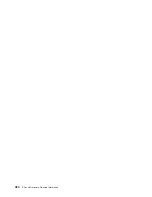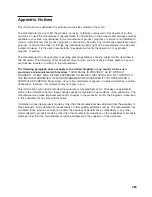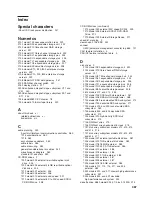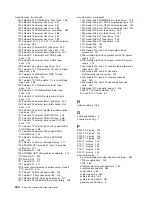
v
The rack/cabinet must be capable of supporting an average load of 15.9 kg (35 lbs.) of product weight
per EIA unit.
For example, a 4 EIA drawer will have a maximum drawer weight of 63.6 kg (140 lb.).
v
Only ac power drawers are supported in the rack/cabinet. It is strongly recommended to use a power
distribution unit (PDU) that meets the same specifications as IBM PDUs to supply rack power. Each
Power Distribution Bus installed in a rack requires a dedicated power line of 200 to 240 V ac and 30 A.
Rack/cabinet power distribution device(s) must meet the drawer power requirements, as well as that of
any additional products that will be connected to the same power distribution device.
The rack/cabinet power receptacle (PDU, UPS or Multi-Outlet Strip) must have a compatible plug type
for your drawer or device.
Note:
Refer to the sales manual for 7014 racks if you want to use power distribution units (PDU) that
are designed for 7014 racks. The customer is responsible for ensuring the PDU is compatible
with the rack/cabinet and assumes responsibility for any/all agency certifications required.
v
The rack/cabinet must be compatible with drawer mounting rails, including a secure and snug fit of the
rail-mounting pins and screws into the rack/cabinet rail support hole.
Note:
If the rack/cabinet has square holes, a plug-in hole adapter may be required.
The rails have been designed and tested to safely support the weight of your drawer or device and to
facilitate service access by allowing the drawer to be safely extended forwards, and for some models,
also backwards. The rails also provide drawer specific anti-tip brackets, rear lock-down brackets, and
cable management guides that require clearance on the rear side of the rails.
The front and rear mounting flanges in the rack/cabinet must be 719 mm (28.3
″
) apart and the internal
width bounded by the mounting flanges at least 494 mm (19.45
″
), for the IBM eServer pSeries rails to fit
in your rack/cabinet (see figure,
Top View of non-IBM Rack Specifications Dimensions
v
The rack/cabinet must have stabilization feet or brackets installed both in the front and rear of the rack,
or have another means of preventing the rack/cabinet from tipping while the drawer or device is pulled
into its extreme front or rear service positions.
Examples of some acceptable alternatives: The rack/cabinet may be securely bolted to the floor, ceiling
or walls, or to adjacent racks/cabinets in a long and heavy row of racks/cabinets. Refer to 7014 Rack
Installation Guides and the individual drawer installation guides for additional information.
v
There must be adequate front and rear service clearances (in and around the rack/cabinet).
The rack/cabinet must have sufficient horizontal width clearance in the front and rear to allow the
drawer to be fully slid into the front and, if applicable, the rear service access positions (typically this
requires 914.4 mm (36
″
) clearance in both the front and rear).
If present, front and rear doors must be able to open far enough to provide unrestrained access for
service or be easily removable. If doors must be removed for service, it is the customer’s responsibility
to remove them prior to service.
v
The rack/cabinet must provide adequate clearance around the rack drawer.
There must be adequate clearance around the drawer bezel so that it can be opened and closed,
according to the product specifications (refer to the 7014 Rack Installation Guides and the individual
drawer installation guides).
Front or rear doors must also maintain a minimum of 51 mm (2
″
) front, 203 mm (8
″
) rear, door to
mounting flange clearance, and 494 mm (19.4
″
) front, 571 mm (22.5
″
) rear, side-to-side clearance for
drawer bezels and cables (see figure,
Top View of non-IBM Rack Specifications Dimensions
on page
Chapter 14. Rack Specifications
377
Summary of Contents for 7012 397
Page 1: ...RS 6000 and Eserver pSeries Site and Hardware Planning Information SA38 0508 20...
Page 2: ......
Page 3: ...RS 6000 and Eserver pSeries Site and Hardware Planning Information SA38 0508 20...
Page 11: ...Appendix Notices 385 Index 387 Contents ix...
Page 12: ...x Site and Hardware Planning Information...
Page 16: ...xiv Site and Hardware Planning Information...
Page 18: ...xvi Site and Hardware Planning Information...
Page 26: ...8 Site and Hardware Planning Information...
Page 238: ...220 Site and Hardware Planning Information...
Page 246: ...228 Site and Hardware Planning Information...
Page 284: ...266 Site and Hardware Planning Information...
Page 296: ...278 Site and Hardware Planning Information...
Page 366: ...348 Site and Hardware Planning Information...
Page 372: ...Async Adapter Cable Planning Chart 354 Site and Hardware Planning Information...
Page 377: ...Standard I O Cable Planning Chart Chapter 12 Cable Planning 359...
Page 380: ...Cable Planning Chart Other Adapters 362 Site and Hardware Planning Information...
Page 384: ...366 Site and Hardware Planning Information...
Page 402: ...384 Site and Hardware Planning Information...
Page 404: ...386 Site and Hardware Planning Information...
Page 413: ......
Page 414: ...Printed in USA SA38 0508 20...
Page 415: ...Spine information RS 6000 and Eserver pSeries Site and Hardware Planning Information...
















































